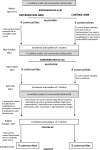A cluster-randomised controlled trial integrating a community-based water, sanitation and hygiene programme, with mass distribution of albendazole to reduce intestinal parasites in Timor-Leste: the WASH for WORMS research protocol
- PMID: 26719316
- PMCID: PMC4710834
- DOI: 10.1136/bmjopen-2015-009293
A cluster-randomised controlled trial integrating a community-based water, sanitation and hygiene programme, with mass distribution of albendazole to reduce intestinal parasites in Timor-Leste: the WASH for WORMS research protocol
Abstract
Introduction: There is limited evidence demonstrating the benefits of community-based water, sanitation and hygiene (WASH) programmes on infections with soil-transmitted helminths (STH) and intestinal protozoa. Our study aims to contribute to that evidence base by investigating the effectiveness of combining two complementary approaches for control of STH: periodic mass administration of albendazole, and delivery of a community-based WASH programme.
Methods and analysis: WASH for WORMS is a cluster-randomised controlled trial to test the hypothesis that a community-based WASH intervention integrated with periodic mass distribution of albendazole will be more effective in reducing infections with STH and protozoa than mass deworming alone. All 18 participating rural communities in Timor-Leste receive mass chemotherapy every 6 months. Half the communities also receive the community-based WASH programme. Primary outcomes are the cumulative incidence of infection with STH. Secondary outcomes include the prevalence of protozoa; intensity of infection with STH; as well as morbidity indicators (anaemia, stunting and wasting). Each of the trial outcomes will be compared between control and intervention communities. End points will be measured 2 years after the first albendazole distribution; and midpoints are measured at 6 months intervals (12 months for haemoglobin and anthropometric indexes). Mixed-methods research will also be conducted in order to identify barriers and enablers associated with the acceptability and uptake of the WASH programme.
Ethics and dissemination: Ethics approval was obtained from the human ethics committees at the University of Queensland, Australian National University, Timorese Ministry of Health, and University of Melbourne. The results of the trial will be published in peer-reviewed journals presented at national and international conferences, and disseminated to relevant stakeholders in health and WASH programmes. This study is funded by a Partnership for Better Health--Project grant from the National Health and Research Council (NHMRC), Australia.
Trial registration number: ACTRN12614000680662; Pre-results.
Keywords: EPIDEMIOLOGY; INFECTIOUS DISEASES; PARASITOLOGY.
Published by the BMJ Publishing Group Limited. For permission to use (where not already granted under a licence) please go to http://www.bmj.com/company/products-services/rights-and-licensing/
Figures


References
Publication types
MeSH terms
Substances
Associated data
LinkOut - more resources
Full Text Sources
Other Literature Sources
Medical
